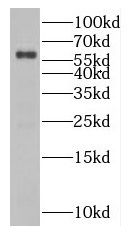Products
MTF2 antibody
| Synonyms: | Metal-response element-binding transcription factor 2|Metal regulatory transcription factor 2|Metal-response element DNA-binding protein M96|Polycomb-like protein 2 (hPCl2)|MTF2|PCL2 antibody | ||
| Catalogue No.: | FNab05397 | Reactivity: | Human, Mouse, Rat |
| Host: | Rabbit | Tested Application: | ELISA, WB, IHC, IF, IP |
| Clonality: | polyclonal | Isotype: | IgG |
| Size | Price |
|---|---|
| 100µg | Inquiry |
- SPECIFICATIONS
- FIGURES
- CONDITIONS
- FAQS
- Product Name
- MTF2 antibody
- Catalogue No.
- FNab05397
- Size
- 100μg
- Form
- liquid
- Purification
- Immunogen affinity purified
- Purity
- ≥95% as determined by SDS-PAGE
- Clonality
- polyclonal
- Isotype
- IgG
- Storage
- PBS with 0.02% sodium azide and 50% glycerol pH 7.3, -20℃ for 12 months(Avoid repeated freeze / thaw cycles.)
- Immunogen
- metal response element binding transcription factor 2
- Alternative Names
- Metal-response element-binding transcription factor 2|Metal regulatory transcription factor 2|Metal-response element DNA-binding protein M96|Polycomb-like protein 2 (hPCl2)|MTF2|PCL2 antibody
- UniProt ID
- Q9Y483
- Observed MW
- 60-61 kDa
- Tested Applications
- ELISA, WB, IHC, IF, IP
- Recommended dilution
- WB: 1:500-1:1000; IP: 1:200-1:1000; IHC: 1:20-1:200; IF: 1:50-1:200
 Jurkat cells were subjected to SDS PAGE followed by western blot with FNab05397(MTF2 antibody) at dilution of 1:600
Jurkat cells were subjected to SDS PAGE followed by western blot with FNab05397(MTF2 antibody) at dilution of 1:600
 IP Result of anti-MTF2 (IP:FNab05397, 4ug; Detection:FNab05397 1:300) with mouse skeletal muscle tissue lysate 4000ug.
IP Result of anti-MTF2 (IP:FNab05397, 4ug; Detection:FNab05397 1:300) with mouse skeletal muscle tissue lysate 4000ug.
 Immunohistochemistry of paraffin-embedded human brain using FNab05397(MTF2 antibody) at dilution of 1:50
Immunohistochemistry of paraffin-embedded human brain using FNab05397(MTF2 antibody) at dilution of 1:50
- Background
- Polycomb group(PcG) that specifically binds histone H3 trimethylated at 'Lys-36'(H3K36me3) and recruits the PRC2 complex. Acts by binding to H3K36me3, a mark for transcriptional activation, and recruiting the PRC2 complex, leading to enhance PRC2 H3K27me3 methylation activity. Regulates the transcriptional networks during embryonic stem cell self-renewal and differentiation. Promotes recruitment of the PRC2 complex to the inactive X chromosome in differentiating XX ES cells and PRC2 recruitment to target genes in undifferentiated ES cells. Required to repress Hox genes by enhancing H3K27me3 methylation of the PRC2 complex. In some conditions may act as an inhibitor of PRC2 activity: able to activate the CDKN2A gene and promote cellular senescence by suppressing the catalytic activity of the PRC2 complex locally. Binds to the metal-regulating-element(MRE) of MT1A gene promoter(By similarity).
How many times can antibodies be recycled?
First, usually it's not suggested to recycle antibodies. After use, buffer system of antibodies has changed. The storage condition of recycled antibodies for different customers also varies. Thus, the performance efficiency of recycled antibodies can’t be guaranteed. Besides, FineTest ever conducted the antibody recycling assay. Assay results show recycling times of different antibodies also varies. Usually, higher antibody titer allows more repeated use. Customers can determine based on experimental requirements.
Notes: After incubation, we recycle rest antibodies to centrifuge tube and store at 4℃. High titer antibodies can be stored for a minimum of one week. Reuse about three times.
What are components of FineTest antibody buffer?
Components of FineTest antibody buffer are usually PBS with proclin300 or sodium azide, BSA, 50% glycerol. Common preservative is proclin300 or sodium azide, which is widely applied in the lab and industry.
How about the storage temperature and duration of FineTest antibodies?
Most antibodies are stored at -20℃. Directly-labeled flow cytometry antibodies should be stored at 2 - 8℃. The shelf life is one year. If after sales issues for purchased antibodies appear, return or replacement is available. Usually, antibodies can be still used after the one-year warranty. We can offer technical support services.
Is dilution required for FineTest antibodies? What’s the dilute solution?
Directly-labeled flow cytometry antibodies are ready-to-use without dilution. Other antibodies are usually concentrated. Follow the dilution ratio suggested in the manual. Dilute solution for different experiments also varies. Common antibody dilution buffers are acceptable(e.g. PBST, TBST, antibody blocking buffer).
How to retrieve antibodies for immunohistochemistry?
Common retrieval buffers: Tris-EDTA Buffer(pH 9.0); Citrate Buffer(pH 6.0)
Heat induced antibody retrieval:
Method 1: Water-bath heating: Put the beaker with retrieval buffer and slide in the boiling water bath. Keep the boiling state for 15min. Naturally cool to room temperature;
Method 2: Microwave retrieval: Put the beaker with retrieval buffer and slide in the microwave oven. Heat at high power for 5min, Switch OFF for 3min, Heat at medium power for 5min. Naturally cool to room temperature.
How to choose secondary antibodies?
(1) Secondary antibodies react with primary antibodies. Thus, secondary antibodies should be against host species of primary antibodies. E.g. If the primary antibody is derived from rabbit, the relevant secondary antibody should be against rabbit. E.g. goat anti rabbit or donkey anti rabbit.
(2) Choose secondary antibody conjugates according to the experimental type, e.g. ELISA, WB, IHC etc. Common enzyme conjugated secondary antibodies are labelled by HRP, AP etc. Fluorescin or dye labelled secondary antibodies are applied in immunofluorescence and flow cytometry(e.g. FITC, Cy3).
